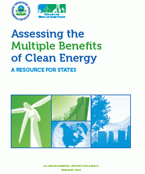Assessing the Multiple Benefits of Clean Energy: A Resource for States
Related Resources
 State clean energy initiatives can generate significant economic, public health and environmental benefits. While the costs of clean energy initiatives get the most attention, less is devoted to the many benefits of clean energy, perhaps because there isn't a clear understanding of the benefits and how to estimate them.
State clean energy initiatives can generate significant economic, public health and environmental benefits. While the costs of clean energy initiatives get the most attention, less is devoted to the many benefits of clean energy, perhaps because there isn't a clear understanding of the benefits and how to estimate them.
Assessing the Multiple Benefits of Clean Energy: A Resource for States (February 2010) address that gap and helps state energy, environmental, and economic policy makers identify and quantify the energy, environmental — specifically greenhouse gas, air, and health — and economic benefits of clean energy. This groundbreaking document is the first to organize and present a comprehensive review of these benefits, together with an analytical framework that states can use to assess those benefits during the development and implementation of clean energy policies and programs.
It includes tips on tools and approaches to use, what to consider when assessing benefits, and examples from state and local governments.
You will need Adobe Reader to view some of the files on this page. See EPA’s About PDF page to learn more.- Chapter 1: Introduction
Chapter 1: Introduction
1.1 What are the Multiple Benefits of Clean Energy? (3)
1.1.1 Energy Savings and Renewable Energy Generation: The Foundation for Benefits (3)
1.1.2 Energy System Benefits (3)
1.1.3 Environmental and Health Benefits (5)
1.1.4 Economic Benefits (6)
1.2 Why Assess the Multiple Benefits of Clean Energy? (8)
1.2.1 Demonstrating the Multiple Benefits of Clean Energy (8)
1.2.2 Designing or Selecting Options that Achieve Greater or Broader Benefits (8)
1.2.3 Identifying Opportunities to Use Clean Energy in Other Planning Processes (9)
1.2.4 Building Support for Clean Energy Policies and Programs (11)
1.3 How do States Assess the Multiple Benefits of Clean Energy? (11)
References (14)
- Chapter 2: Assessing the Potential Energy Impacts of Clean Energy Initiatives
Chapter 2: Assessing the Potential Energy Impacts of Clean Energy Initiatives
2.1 How Do Clean Energy Policies Affect Energy? (20)
2.2 How Can States Estimate the Potential Direct Energy Impacts of Clean Energy Policies? (21)
2.2.1 STEP 1: Develop a Business-As-Usual Energy Forecast (22)
2.2.2 STEP 2: Quantify Implications of Targets and Goals (33)
2.2.3 STEP 3: Estimate Potential Direct Energy Impacts (35)
2.2.4 STEP 4: Create an Alternative Policy Forecast (44)
2.3 Case Studies (45)
2.3.1 Texas Building Code (45)
2.3.2 Vermont – Energy and Energy Savings Forecasting (47)
Information Resources (49)
References (50)
- Chapter 3: Assessing the Electric System Benefits of Clean Energy
Chapter 3: Assessing the Electric System Benefits of Clean Energy
3.1 How Clean Energy Can Achieve Electric System Benefits (53)
3.1.1 The Structure of the U.S. Energy System (53)
3.1.2 Primary and Secondary Benefits of Clean Energy (54)
3.2 How States Can Estimate the Electric System Benefits of Clean Energy (56)
3.2.1 How to Estimate the Primary Electric System Benefits of Clean Energy Resources (61)
3.2.2 How to Estimate the Secondary Electric System Benefits of Clean Energy Resources (77)
3.3 Case Studies (83)
3.3.1 California Utilities' Energy Efficiency Programs (83)
3.3.2 Energy Efficiency and Distributed Generation in Massachusetts (85)
Information Resources (86)
References (89)
- Chapter 4: Assessing the Air Pollution, Greenhouse Gas, Air Quality...
Chapter 4: Assessing the Air Pollution, Greenhouse Gas, Air Quality, and Health Benefits of Clean Energy Initiatives
4.1 How Clean Energy Initiatives Result in Air and Health Benefits (95)
4.2 How States Estimate the GHG, Air, and Health Benefits of Clean Energy (98)
4.2.1 Step 1: Develop and Project a Baseline Emissions Profile (98)
4.2.2 Step 2: Quantify Air and GHG Emission Reductions from Clean Energy Measures (107)
4.2.3 Step 3: Quantify Air Quality Impacts (115)
4.2.4 Step 4: Quantify Human Health and Related Economic Effects of Air Quality Impacts (119)
4.3 Case Studies (124)
4.3.1 Texas Emissions Reduction Plan (TERP) (124)
4.3.2 Wisconsin – Focus on Energy Program (125)
Information Resources (127)
References (130)
- Chapter 5: Assessing the Economic Benefits of Clean Energy Initiatives
Chapter 5: Assessing the Economic Benefits of Clean Energy Initiatives
5.1 How Clean Energy Initiatives Create Macroeconomic Benefits (134)
5.1.1 What are the Direct Effects of Demand-Side Initiatives? (135)
5.1.2 What are the Direct Effects of Supply-Side Initiatives? (136)
5.1.3 What are the Indirect and Induced Effects of Clean Energy Initiatives? (137)
5.2 How Can States Estimate the Macroeconomic Benefits of Clean Energy Initiatives? (138)
5.2.1 Step 1: Determine the Method of Analysis and Level of Effort (138)
5.2.2 Step 2: Quantify Expenditures and Savings from the Clean Energy Initiative (148)
5.2.3 Step 3: Apply the Method to Quantify Macroeconomic Effects (153)
5.3 Case Studies (154)
5.3.1 New York: Analyzing Macroeconomic Benefits of the Energy $mart Program (154)
5.3.2 Illinois: Analyzing the Macroeconomic Benefits of Clean Energy Development (156)
Sampling of State Clean Energy Analyses by Type of Analytic Method (157)
Information Resources (159)
References (159)
